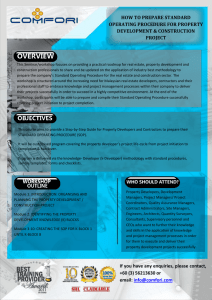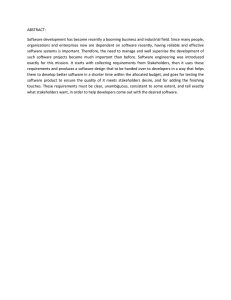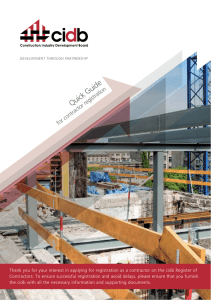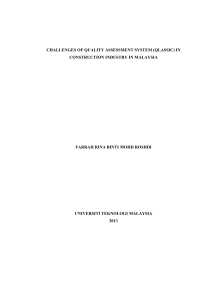1 The Construction Industry Standard ( CIS 7:2006) on Quality... System was developed on November 2006 to evaluate and improve...
advertisement
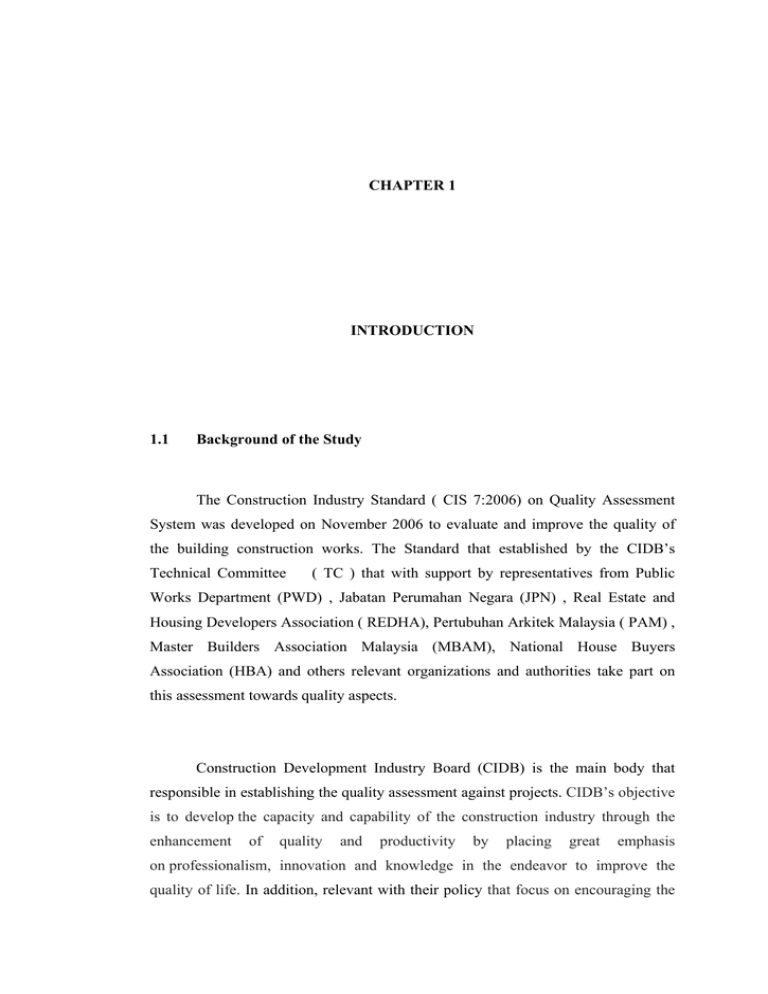
1 CHAPTER 1 INTRODUCTION 1.1 Background of the Study The Construction Industry Standard ( CIS 7:2006) on Quality Assessment System was developed on November 2006 to evaluate and improve the quality of the building construction works. The Standard that established by the CIDB’s Technical Committee ( TC ) that with support by representatives from Public Works Department (PWD) , Jabatan Perumahan Negara (JPN) , Real Estate and Housing Developers Association ( REDHA), Pertubuhan Arkitek Malaysia ( PAM) , Master Builders Association Malaysia (MBAM), National House Buyers Association (HBA) and others relevant organizations and authorities take part on this assessment towards quality aspects. Construction Development Industry Board (CIDB) is the main body that responsible in establishing the quality assessment against projects. CIDB’s objective is to develop the capacity and capability of the construction industry through the enhancement of quality and productivity by placing great emphasis on professionalism, innovation and knowledge in the endeavor to improve the quality of life. In addition, relevant with their policy that focus on encouraging the 2 award of construction contracts based on "value for money" rather than cost efficiency, ensuring that Construction products, especially those that are locally manufactured, confirm to the standing Industry Standards, ensuring that skilled labour confirm to the standing National Skills Standards and ensuring that Construction Firms are encouraged to enhance their quality to eventually achieve competitive advantage in the global market. With consumer sophistication as a key driving force for quality in construction, CIDB has spearheaded a number of farreaching initiatives that are designed to enhance quality. Quality is defined as a fundamentally relational. The ongoing process that comprises sustaining the relationships by doing assess, anticipate, fulfill stated and implied needs can achieve the quality. Even though the quality process is implicit process while it involves many relationships and character, the principles ‘’Do the Right Things in Every Time, On Time and First Time ‘’will remain the quality. The definition of quality in terms of building construction should be within the building standard and specification. Furthermore, analyzing the quality of the building should be developed by the assessment by time to time from the beginning until the end stages of the construction work. The assessment on the construction classified on the building category. For example Landed Housing, Stratified Housing or Public Building. The Technical Committee (TC) team set up the Quality Assessment System in Construction (QLASSIC) to give a level of standard that can award to the Developers or Contractors as successful parties in construction industry. This system or method is to measure the quality of a workmanship of a construction work based on the relevant approved standard. QLASSIC set out the standard on quality of workmanship for various construction elements of building and also infrastructure works upon completion of the projects. The elements in assessments include Structural Works, Architectural Works, and Mechanical and Electrical Works (M&E). QLASSIC enables the quality of workmanship in construction projects to be objectively highlighted through a scoring system. The marks are summed up to calculate the QLASSIC Score (%) for a construction projects. The 3 results are derived from the site inspection that carried out on the first time inspection within the elements of the building from upon completion of the projects. For the works that are rectified after assessment will not be summed up into the score. Nowadays, knowledgeable customers are very particular on the quality aspects of the building. They desire for a value for money building, zero defects, zero risk and sustainable development for their selection of living especially for residential area wherever for short term or long term. Furthermore, the QLASSIC approach was still new in the construction industry development. The encouragement in application of QLASSIC for every project should be highly suggested by the Construction Development Industry Development (CIDB) Malaysia. 1.2 Statements of Problem QLASSIC was developed by CIDB on 2006, however, the application of this system are actively applied by the Major Private Client such as Sime Darby Property Sdn Bhd,TTDI Harta Sdn Bhd, PJD Eastern Land Sdn Bhd , Perumahan Kinrara Bhd,Sime Pilmoor Development Sdn Bhd, I&P Sieramas Sdn Bhd and other developers which is only the well-known client. For government project, there are a small number of projects and rarely applied this assessment system. In other words, QLASSIC was a minor application in construction industry as far as QLASSIC is not a compulsory requirement for the Developers and Contractors to bid to the projects. The score of the construction works was first published on 2007. From the publications, it shows that the QLASSIC was still a new establishment that focuses on the quality of a workmanship in construction industry. The scoring system is to benchmark the quality of workmanship of the construction projects. While the constructions of works complied with the standard of quality, the objectives of the 4 quality development were achieved. QLASSIC also introduce the performance of the Developers and Contractors based on their workmanship after the completion of the projects. QLASSIC score drastically will enhance the Developer’s and Contractor’s good background and performance during the construction and completion of the construction project. Hence, QLASSIC was a very familiar system among the several Developers and Contractors. Furthermore, the parties that comply with the QLASSIC are more advance in the development of the construction projects. There are more aware on the quality of a workmanship and more successful in delivering the construction projects by following the standards of quality. Therefore, an exposure to work within the standard of quality is already in their organizations strategy. QLASSIC was not fully implemented and applied by all Developers or Contractors in Malaysia as there is not a compulsory requirement. Moreover, there are a small number of Developers and Contractors that aware on the benefits of application QLASSIC in their construction projects. In addition, it shows that there are some barriers that make those parties not comply with QLASSIC. The barriers give the tough challenges to CIDB in order to ensure QLASSIC is totally applied by all Developers and Contractors in construction industry. 1.3 Objectives of the Study The aims of this study is to study on challenges of QLASSIC and its acceptance by Developers and Contractors that register under the CIDB, Malaysia for the construction projects as to achieve the standard of quality in construction in terms of workmanship. 5 In order to achieve the aim of the study, the following objectives have been identified: a) To identify the driving factors to the application of QLASSIC b) To identify the barriers in complying a QLASSIC c) To establish the improvement and strategy of barrier breaker towards QLASSIC application 1.4 Scope of the Study In order to achieve the objectives for this study, the scope of the study will be focusing on the challenges of QLASSIC within Developers and Contractors in construction industry in Malaysia.

